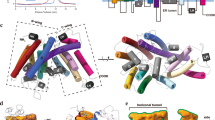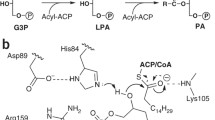Abstract
The structural importance of the acyl group in lysophosphatidylcholine (LPC) as substrate of purified bovine lysophospholipase D (lysoPLD) was investigated. Among LPCs with saturated acyl chains, the K m value decreased according to the length of the acyl chain (C12–C16) up to the palmitoyl group, while the V m value showed no remarkable change. But, the extension of the acyl size to C18, as observed with 1-stearoyl LPC (K m, 8.5 mM), rather resulted in a remarkable increase in the K m value. Meanwhile, the introduction of one double bond in the C18 saturated acyl chain led to a remarkable reduction in the K m value, as observed with 1-oleoyl LPC (K m, 0.48 mM). Furthermore, 1-linoleoyl LPC (K m, 56 μM) with two double bonds exhibited a smaller K m value than 1-oleoyl LPC, suggesting that the unsaturation degree might be important in augmenting the binding affinity of LPCs. A similar phenomenon was also observed with 1-arachidonoly LPC (K m, 79 μM) or 1-docosahexaenoyl LPC (K m, 36 μM). Overall, the order of catalytic efficiency (V m/K m value) of those LPCs seemed to be affected by the K m value rather than the V m value, which differed by at most threefold among LPC derivatives. Next, the introduction of a hydroperoxide group into 1-linoleoyl-LPC or 1-arachidonoyl LPC led to a further reduction in K m values (1-hydroperoxylinoleoyl LPC, 26 μM; 1-hydroperoxyarachidonoyl LPC, 33 μM), accompanied by a further increase in the V m/K m values. Additionally, phosphatidylcholines (PCs) with an oxidized acyl chain at sn-2 position were found to be efficient as 1-palmitoyl LPC as substrates of lysoPLD. Taken together, the catalytic efficiency of LPCs or oxidized PCs as substrates of lysoPLD seems to be determined by the property of the acyl chain, length of the acyl chain, unsaturation degree and oxidation status.



Similar content being viewed by others
Abbreviations
- LysoPLD:
-
Lysophospholipase D
- LPC:
-
Lysophosphatidylcholine
- LPA:
-
Lysophosphatidic acid
- PC:
-
Phosphatidylcholine
- AzPC:
-
1-Palmitoyl-2-azelaoyl-sn-glycero-3-phosphocholine
- PGPC:
-
1-Palmitoyl-2-glutaroyl-sn-glycero-3-phosphocholine
References
van Meeteren LA, Moolenaar WH (2007) Regulation and biological activities of the autotaxin-LPA axis. Prog Lipid Res 46:145–160
Wykle RL, Schremmer JM (1974) A lysophospholipase D pathway in the metabolism of ether-linked lipids in brain microsomes. J Biol Chem 249:1742–1746
Yamashita M, Homma H, Inoue K, Nojima S (1983) The metabolism of platelet activating factor in platelets and plasma of various animals. J Toxicol Sci 8:177–188
Tokumura A, Miyake M, Nishioka Y, Yamano S, Aono T, Fukuzawa K (1999) Production of lysophosphatidic acids by lysophospholipase D in human follicular fluids of in vitro fertilization patients. Biol Reprod 61:195–199
Tokumura A, Fujimoto H, Yoshimoto O, Nishioka Y, Miyake M, Fukuzawa K (1999) Production of lysophosphatidic acid by lysophospholipase D in incubated plasma of spontaneously hypertensive rats and Wistar Kyoto rats. Life Sci 65:245–253
Gesta S, Simon M, Rey A, Sibrac D, Girard A, Lafontan M, Valet P, Saulnier-Blache J (2002) Secretion of a lysophospholipase D activity by adipocytes, involvement in lysophosphatidic acid synthesis. J Lipid Res 43:904–910
Clair T, Lee HY, Liotta LA, Stracke ML (1997) Autotaxin is an exoenzyme possessing 5′-nucleotide phosphodiesterase/ATP pyrophosphatase and ATPase activities. J Biol Chem 272:996–1001
van Meeteren LA, Ruurs P, Christodoulou E, Goding JW, Takakusa H, Kikuchi K, Perrakis A, Nagano T, Moolenaar WH (2005) Inhibition of autotaxin by lysophosphatidic acid and sphingosine 1-phosphate. J Biol Chem 280:21155–21161
Aoki J, Taira A, Takanezawa Y, Kishi Y, Hama K, Kishimoto T, Mizuno K, Saku K, Taguchi R, Arai H (2002) Serum lysophosphatidic acid is produced through diverse phospholipase pathways. J Biol Chem 277:39696–39702
Clair T, Aoki J, Koh E, Bandle RW, Nam SW, Ptaszynska MM, Mills GB, Schiffmann E, Liotta LA, Stracke ML (2003) Autotaxin hydrolyzes sphingosylphosphorylcholine to produce the regulator of migration, sphingosine-1-phosphate. Cancer Res 63:5446–5453
Sano T, Baker D, Virag T, Wada A, Yatomi Y, Kobayashi T, Igarashi Y, Tigyi G (2002) Multiple mechanisms linked to platelet activation result in lysophosphatidic acid and sphingosine 1-phosphate generation in blood. J Biol Chem 277:21197–21206
Eichholtz T, Jalink K, Fahrenfort I, Moolenaar WH (1993) The bioactive phospholipid lysophosphatidic acid is released from activated platelets. Biochem J 291:677–680
Baker DL, Morrison P, Miller B, Riely CA, Tolley B, Westermann AM, Bonfrer JM, Bais E, Moolenaar WH, Tigyi G (2002) Plasma lysophosphatidic acid concentration and ovarian cancer. J Am Med Assoc 287:3081–3082
Okita M, Gaudette DC, Mills GB, Holub BJ (1997) Elevated levels and altered fatty acid composition of plasma lysophosphatidylcholine (lysoPC) in ovarian cancer patients. Int J Cancer 71:31–34
Croset M, Brossard N, Polette A, Lagarde M (2000) Characterization of plasma unsaturated lysophosphatidylcholines in human and rat. Biochem J 345:61–67
Ojala PJ, Hirvonen TE, Hermansson M, Somerharju P, Parkkinen J (2007) Acyl chain-dependent effect of lysophosphatidylcholine on human neutrophils. J Leukoc Biol 82:1501–1509
Aoki J (2004) Mechanisms of lysophosphatidic acid production. Semin Cell Dev Biol 15:477–489
Baker DL, Fujiwara Y, Pigg KR, Tsukahara R, Kobayashi S, Murofushi H, Uchiyama A, Murakami-Murofush K, Koh E, Bandle RW, Byun HS, Bittman R, Fan D, Murph M, Mills GB, Tigyi G (2006) Carba analogs of cyclic phosphatidic acid are selective inhibitors of autotaxin and cancer cell invasion and metastasis. J Biol Chem 281:22786–22793
Liu XW, Sok DE, Yook HS, Sohn CB, Chung YJ, Kim MR (2007) Inhibition of lysophospholipase D activity by unsaturated lysophosphatidic acids or seed extracts containing 1-linoleoyl and 1-oleoyl lysophosphatidic acid. J Agric Food Chem 55:8717–8722
Tokumura A, Nishioka Y, Yoshimoto O, Shinomiya J, Fukuzawa K (1999) Substrate specificity of lysophospholipase D which produces bioactive lysophosphatidic acids in rat plasma. Biochim Biophys Acta 1437:235–245
Sugimoto S, Sugimoto H, Aoyama C, Aso C, Mori M, Izumi T (2006) Purification and characterization of lysophospholipase D from rat brain. Biochim Biophys Acta 1761:1410–1418
Tokumura A, Sinomiya J, Kishimoto S, Tanaka T, Kogure K, Sugiura T, Satouchi K, Waku K, Fukuzawa K (2002) Human platelets respond differentially to lysophosphatidic acids having a highly unsaturated fatty acyl group and alkyl ether-linked lysophosphatidic acids. Biochem J 365:617–628
Roberts MF, Deems RA, Dennis EA (1977) Dual role of interfacial phospholipid in phospholipase A2 catalysis. Proc Natl Acad Sci USA 74:1950–1954
Huang LS, Kim MR, Jeong TS, Sok DE (2007) Linoleoyl lysophosphatidic acid and linoleoyl lysophosphatidylcholine are efficient substrates for mammalian lipoxygenases. Biochim Biophys Acta 1770:1062–1070
Huang LS, Kim MR, Sok DE (2007) Oxygenation of 1-docosahexaenoyl lysophosphatidylcholine by lipoxygenases; conjugated hydroperoxydiene and dihydroxytriene derivatives. Lipids 42:981–990
Tokumura A, Majima E, Kariya Y, Tominaga K, Kogure K, Yasuda K, Fukuzawa K (2002) Identification of human plasma lysophospholipase D, a lysophosphatidic acid-producing enzyme, as autotaxin, a multifunctional phosphodiesterase. J Biol Chem 277:39436–39442
Umezu-Goto M, Kishi Y, Taira A, Hama K, Dohmae N, Takio K, Yamori T, Mills GB, Inoue K, Aoki J, Arai H (2002) Autotaxin has lysophospholipase D activity leading to tumor cell growth and motility by lysophosphatidic acid production. J Cell Biol 158:227–233
Bradford M (1976) A rapid and sensitive method for quantitation of microgram quantities of protein utilizing the principle of protein-dye binding. Anal Biochem 72:248–254
Egmond MR, Brunori M, Fasella PM (1976) The steady-state kinetics of the oxygenation of linoleic acid catalysed by soybean lipoxygenase. Eur J Biochem 61:93–100
Ferguson CG, Bigman CS, Richardson RD, van Meeteren LA, Moolenaar WH, Prestwich GD (2006) Fluorogenic phospholipid substrate to detect lysophospholipase D/autotaxin activity. Org Lett 8:2023–2026
Steel RGD, Torrie JH (1960) Analysis of variance I: the one-way classification, principles and procedures of statistics. McGraw-Hill, New York, pp 99–132
Arlt S, Beisiegel U, Kontush A (2002) Lipid peroxidation in neurodegeneration: new insights into Alzheimer’s disease. Curr Opin Lipidol 13:289–294
Christopher J, Axelrod B (1971) On the different positional specificities of peroxidation of linoleate shown by two isozymes of soybean lipoxygenase. Biochem Biophys Res Commun 44:731–736
Li Z, Mintzer E, Bittman R (2004) The critical micelle concentrations of lysophosphatidic acid and sphingosylphosphorylcholine. Chem Phys Lipids 130:197–201
Kumar VV, Baumann WJ (1991) Lanthanide-induced phosphorus-31 NMR downfield chemical shifts of lysophosphatidylcholines are sensitive to lysophospholipid critical micelle concentration. Biophys J 59:103–107
Acknowledgments
This study was supported by the Korea Research Foundation Grant funded by the Korean Government (MOEHRD, Basic Research Promotion Fund) (KRF-2007-531-C00067).
Author information
Authors and Affiliations
Corresponding author
About this article
Cite this article
Liu, XW., Sok, DE., Yook, HS. et al. Structural Importance of the Acyl Group in Substrate Specificity of Purified Bovine Lysophospholipase D. Lipids 43, 431–439 (2008). https://doi.org/10.1007/s11745-008-3162-9
Received:
Accepted:
Published:
Issue Date:
DOI: https://doi.org/10.1007/s11745-008-3162-9




